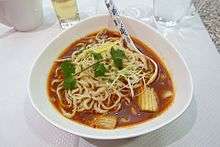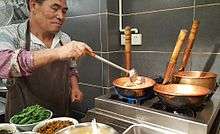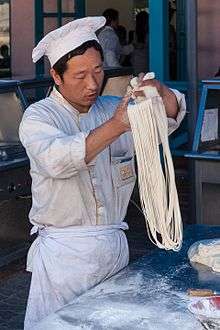Noodle
|
| |
| Type | Noodle |
|---|---|
| Main ingredients | Unleavened dough |
| Variations | Numerous |
|
| |
Noodles are a staple food in many cultures made from unleavened dough which is stretched, extruded, or rolled flat and cut into one of a variety of shapes. While long, thin strips may be the most common, many varieties of noodles are cut into waves, helices, tubes, strings, or shells, or folded over, or cut into other shapes. Noodles are usually cooked in boiling water, sometimes with cooking oil or salt added. They are often pan-fried or deep-fried. Noodles are often served with an accompanying sauce or in a soup. Noodles can be refrigerated for short-term storage, or dried and stored for future use. The material composition or geocultural origin must be specified when discussing noodles. The word derives from the German word Nudel.[1]
History
The origin of noodles has been disputed. Claims have been made that the noodle was of Chinese,[2][3] Arabian and Mediterranean origin.[4] A Nature article claimed the oldest evidence of noodle consumption was from 4,000 years ago in China.[5] In 2005, a team of archaeologists working in the People's Republic of China reported finding an earthenware bowl that contained foxtail millet and broomcorn millet[6] noodles at the Lajia archaeological site, arguably hailing from the late neolithic period, but this claim was disputed by later research,[7] which suggested that noodles simply cannot be produced from millet, which lacks gluten.[8]
The earliest written record of noodles is found in a book dated to the Eastern Han period (25–220).[5] Noodles, often made from wheat dough, became a staple food for people of the Han Dynasty (206 BCE - 220 CE).[9] During the Tang Dynasty, the noodles were first cut into strips, and in the Yuan Dynasty the making of dried noodles began.
Asia
Wheat noodles in Japan (udon) were adapted from a Chinese recipe by a Buddhist monk as early as the 9th century. Reshteh noodles were eaten by the people of Persia by the 13th century. Innovations continued, as for example, noodles made from buckwheat (naengmyeon) were developed in the Joseon Dynasty of Korea (1392–1897). Ramen noodles, based on Chinese noodles, became popular in Japan by 1900.

Instant noodles were invented by Momofuku Ando and first marketed in Japan in 1958.[10] According to Ando's method, a bundle of fresh noodles is flash-fried, which dries them out and provides for a long shelf life.
Europe and the Near East
In the 1st century BCE, Horace wrote of fried sheets of dough called lagana.[11] However, the method of cooking these sheets of dough, lagana, does not correspond to the current definition of either a fresh or dry pasta product, which only had similar basic ingredients and perhaps the shape.[12] In the 2nd century CE, the Greek physician Galen mentioned itrion, referring to all homogenous mixtures from flour and water.[13] The Latinized itrium was used as a reference to a kind of boiled dough.[13] The Jerusalem Talmud records that itrium was common in the Byzantine Provinces of Palaestina Prima and Palaestina Secunda from the 3rd to 5th centuries CE.[14] Arabs adapted noodles for long journeys in the 5th century, the first written record of dry pasta. The 9th-century Arab physician Isho bar Ali defines itriyya, the Arabic cognate of the Greek word, as string-like shapes made of semolina and dried before cooking.[15] Muhammad al-Idrisi wrote in 1154 that itriyya was manufactured and exported from Norman Sicily. Itriya was also known by the Aramaic speakers under the Persian sphere and during the Islamic rule referred to a small soup noodle prepared by twisting bits of kneaded dough into shape.[16]
The first concrete information on pasta products in Italy dates to the 13th or 14th centuries.[17] This would reflect Europeans, like Padre Giovanni del Carpini, traveling to Asia prior to the Venetian Polo family in the 13th century.[18] Pasta has taken on a variety of shapes, often based on regional specializations. Since at least the 20th century, pasta has become a staple in North America and elsewhere.
In the area that would become Germany, written mention of Spätzle has been found in documents dating from 1725, although medieval illustrations are believed to place this noodle at an even earlier date.[19]
Types by primary ingredient
Wheat
Rice Mixian (米线) rice noodles being cooked in copper pots (铜锅) on gas elements at a noodle restaurant in Kunming (昆明), Yunnan (云南), China.
|
 Some different types of noodles commonly found in Southeast Asia Wide, uncooked egg noodles. Buckwheat
Others
|
Types of dishes

- Baked noodles: Boiled and drained noodles are combined with other ingredients and baked. Popular examples include lasagne and many casseroles.
- Basic noodles: These are cooked in water or broth, then drained. Other foods can be added or the noodles are added to other foods (see fried noodles) or the noodles can be served plain with a dipping sauce or oil to be added at the table. In general, noodles are soft and absorb flavors.
- Chilled noodles: noodles that are served cold, sometimes in a salad. Examples include Thai glass noodle salad and cold udon.
- Fried noodles: dishes made of noodles stir fried with various meats, seafood, vegetables, and dairy products. Typical examples include chow mein, lo mein, mie goreng, hokkien mee, some varieties of pancit, yakisoba, Curry Noodles, and pad thai.
- Noodle soup: noodles served in broth. Examples are phở, beef noodle soup, chicken noodle soup, ramen, laksa, saimin, and batchoy.
Preservation
See also
| Look up noodle in Wiktionary, the free dictionary. |
| Wikimedia Commons has media related to Noodles. |
References
- ↑ Harper, Douglas. "noodle". Online Etymology Dictionary. Retrieved 14 October 2009.
- ↑ "The History of Noodles: How a Simple Food Became a Worldwide Staple". The Atlantic.
- ↑ "A short history of Japan’s long noodles". The Japan Times.
- ↑ Serventi & Sabban 2002, pp. 271-344.
- 1 2 Roach, John (12 October 2005). "4,000-Year-Old Noodles Found in China". National Geographic. pp. 1–2.
- ↑ Lu, Houyuan; Yang, Xiaoyan; Ye, Maolin; et al. (13 October 2005). "Culinary archaeology: Millet noodles in Late Neolithic China". Nature. 437 (7061): 967. PMID 16222289. doi:10.1038/437967a.
- ↑ Ge, W.; Liu, L.; Chen, X.; Jin, Z. (2011). "Can noodles be made from millet? An experimental investigation of noodle manufacture together with starch grain analyses". Archaeometry. 53: 194–204. doi:10.1111/j.1475-4754.2010.00539.x.
- ↑ Sabban, Francoise (17 October 2012). "A scientific controversy in China over the origins of noodles". Open Edition. Retrieved 25 November 2015.
- ↑ Sinclair & Sinclair 2010, p. 91.
- ↑ "Momofuku Ando". The Sunday Times. TIMESONLINE. 10 January 2007.(subscription required)
- ↑ Serventi & Sabban 2002, pp. 15–16 & 24.
- ↑ Serventi & Sabban 2002, pp. 15–16.
- 1 2 Serventi & Sabban 2002, p. 17.
- ↑ Serventi & Sabban 2002, p. 29.
- ↑ "A medical text in Arabic written by a Jewish doctor living in Tunisia in the early 900s" (Dickie 2008: 21).
- ↑ Rodinson, Perry & Arberry 2001, p. 253.
- ↑ Serventi & Sabban 2002, p. 10.
- ↑ Bergreen, L. Marco Polo: From Venice to Xanadu, 2007.
- ↑ "City Profile: Stuttgart" (PDF). London: Embassy of Germany, London. Retrieved 26 November 2015.
Spätzle is a city specialty.
Bibliography
- Dickie, John (1 October 2010), Delizia! The Epic History of Italians and Their Food (Paper), New York: Atria Books, ISBN 0743278070
- Errington, Frederick et al. eds. The Noodle Narratives: The Global Rise of an Industrial Food into the Twenty-First Century (U. of California Press; 2013) 216 pages; studies three markets for instant noodles: Japan, the United States, and Papua New Guinea.
- Rodinson, Maxime; Perry, Charles; Arberry, Arthur J. (2001). Medieval Arab Cookery (Hardback). United Kingdom: Prospect Books. p. 253. ISBN 0907325912.
- Serventi, Silvano; Sabban, Françoise (2002). Pasta: the Story of a Universal Food. New York: Columbia University Press. ISBN 0231124422.
- Sinclair, Thomas R.; Sinclair, Carol Janas (2010). Bread, beer, and the seeds of change: Agriculture's imprint on world history. Wallingford: CABI. p. 91. ISBN 978-1-84593-704-1.

